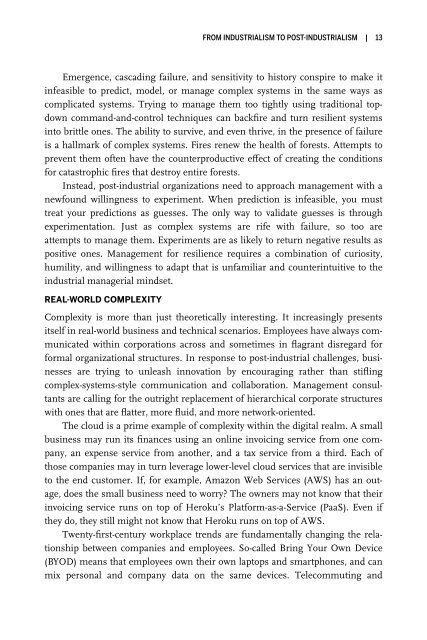Designing Delivery
1Tox6aC
1Tox6aC
Create successful ePaper yourself
Turn your PDF publications into a flip-book with our unique Google optimized e-Paper software.
FROM INDUSTRIALISM TO POST-INDUSTRIALISM | 13<br />
Emergence, cascading failure, and sensitivity to history conspire to make it<br />
infeasible to predict, model, or manage complex systems in the same ways as<br />
complicated systems. Trying to manage them too tightly using traditional topdown<br />
command-and-control techniques can backfire and turn resilient systems<br />
into brittle ones. The ability to survive, and even thrive, in the presence of failure<br />
is a hallmark of complex systems. Fires renew the health of forests. Attempts to<br />
prevent them often have the counterproductive effect of creating the conditions<br />
for catastrophic fires that destroy entire forests.<br />
Instead, post-industrial organizations need to approach management with a<br />
newfound willingness to experiment. When prediction is infeasible, you must<br />
treat your predictions as guesses. The only way to validate guesses is through<br />
experimentation. Just as complex systems are rife with failure, so too are<br />
attempts to manage them. Experiments are as likely to return negative results as<br />
positive ones. Management for resilience requires a combination of curiosity,<br />
humility, and willingness to adapt that is unfamiliar and counterintuitive to the<br />
industrial managerial mindset.<br />
REAL-WORLD COMPLEXITY<br />
Complexity is more than just theoretically interesting. It increasingly presents<br />
itself in real-world business and technical scenarios. Employees have always communicated<br />
within corporations across and sometimes in flagrant disregard for<br />
formal organizational structures. In response to post-industrial challenges, businesses<br />
are trying to unleash innovation by encouraging rather than stifling<br />
complex-systems-style communication and collaboration. Management consultants<br />
are calling for the outright replacement of hierarchical corporate structures<br />
with ones that are flatter, more fluid, and more network-oriented.<br />
The cloud is a prime example of complexity within the digital realm. A small<br />
business may run its finances using an online invoicing service from one company,<br />
an expense service from another, and a tax service from a third. Each of<br />
those companies may in turn leverage lower-level cloud services that are invisible<br />
to the end customer. If, for example, Amazon Web Services (AWS) has an outage,<br />
does the small business need to worry? The owners may not know that their<br />
invoicing service runs on top of Heroku’s Platform-as-a-Service (PaaS). Even if<br />
they do, they still might not know that Heroku runs on top of AWS.<br />
Twenty-first-century workplace trends are fundamentally changing the relationship<br />
between companies and employees. So-called Bring Your Own Device<br />
(BYOD) means that employees own their own laptops and smartphones, and can<br />
mix personal and company data on the same devices. Telecommuting and


